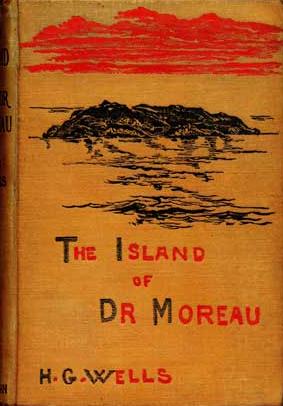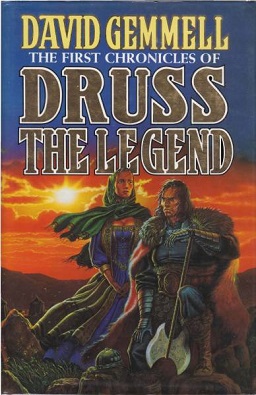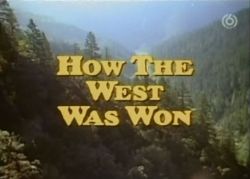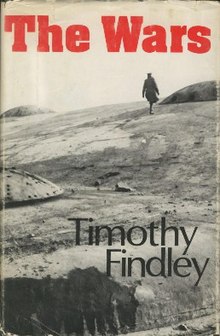
Of Mice and Men is a 1937 novella written by American author John Steinbeck. It describes the experiences of George Milton and Lennie Small, two displaced migrant ranch workers, as they move from place to place in California, searching for jobs during the Great Depression.

The Island of Doctor Moreau is an 1896 science fiction novel by English author H. G. Wells. It was published on 1 January 1896. The novel is set between 21 January 1887 to 5 January 1888. The text of the novel is the narration of Edward Prendick, a shipwrecked man rescued by a passing boat. He is left on the island home of Doctor Moreau, a mad scientist who creates human-like hybrid beings from animals via vivisection. The novel deals with a number of themes, including pain and cruelty, moral responsibility, human identity, human interference with nature, and the effects of trauma. Wells described it as "an exercise in youthful blasphemy."

Crazy Horse was a Lakota war leader of the Oglala band in the 19th century. He took up arms against the United States federal government to fight against encroachment by White American settlers on Native American territory and to preserve the traditional way of life of the Lakota people. His participation in several famous battles of the Black Hills War on the northern Great Plains, among them the Fetterman Fight in 1866, in which he acted as a decoy, and the Battle of the Little Bighorn in 1876, in which he led a war party to victory, earned him great respect from both his enemies and his own people.

Hannibal Rising is a psychological horror novel by American author Thomas Harris, published in 2006. It is the fourth and final novel in Harris's series and the first novel in chronological order of the novels of Thomas Harris centered around Dr. Hannibal Lecter, serving as a prequel to his three previous books featuring his most famous character, the cannibalistic serial killer Dr. Hannibal Lecter. The novel was released with an initial printing of at least 1.5 million copies and met with a mixed critical response. Audiobook versions have also been released, with Harris reading the text. The novel was adapted into a film of the same name in 2007, directed by Peter Webber. Producer Dino De Laurentiis implied around the time of the novel's release that he had coerced Harris into writing it under threat of losing control over the Hannibal Lecter character, accounting for the perceived diminished quality from Harris' previous books.

The First Chronicles of Druss the Legend is a fantasy novel by British author David Gemmell, first published in 1993. The novel is a prequel to the popular title Legend. The novel details the early life and events of the character Druss, and is followed by The Legend of Deathwalker, which deals with later events in his life between this book and the events in Legend.

Watchers is a 1988 science fiction horror film directed by Jon Hess and starring Corey Haim, Michael Ironside, Barbara Williams, and Lala Sloatman. It is loosely based on the 1987 novel Watchers by Dean R. Koontz.

How the West Was Won is an American Western television series that starred James Arness, Eva Marie Saint, Fionnula Flanagan, Bruce Boxleitner, and Richard Kiley. Loosely based on the 1962 Cinerama film of the same name, it began with a two-hour television film, The Macahans, in 1976, followed by a mini-series in 1977, and a regular series in 1978 and 1979.

Margery Williams Bianco was an English-American author, primarily of popular children's books. A professional writer since the age of nineteen, she achieved lasting fame at forty-one with the 1922 publication of the classic that is her best-known work, The Velveteen Rabbit. She received the Newbery Honor for Winterbound.

Ivanhoe is a 1952 historical adventure epic film directed by Richard Thorpe and produced by Pandro S. Berman for Metro-Goldwyn-Mayer. The film was shot in Technicolor, with a cast featuring Robert Taylor, Elizabeth Taylor, Joan Fontaine, George Sanders, Emlyn Williams, Finlay Currie, Felix Aylmer, and Sebastian Cabot. The screenplay is written by Æneas MacKenzie, Marguerite Roberts, and Noel Langley, based on the 1819 historical novel Ivanhoe by Sir Walter Scott.

Strange Meeting is a novel by Susan Hill about the First World War. The title of the book is taken from a poem by the First World War poet Wilfred Owen. The novel was first published by Hamish Hamilton in 1971 and then by Penguin Books in 1974.
Sharpe's Battle is a 1995 British television drama, the seventh of a series screened on the ITV network that follows the career of Richard Sharpe, a fictional British soldier during the Napoleonic Wars. It is somewhat based on the 1995 novel of the same name by Bernard Cornwell, though the film is set in 1813 on the Spanish-French border, rather than in 1811 on the border with Portugal.
Sharpe's Sword is a 1995 British television drama, the eighth of a series screened on the ITV network that follows the career of Richard Sharpe, a fictional British soldier during the Napoleonic Wars. It is based on the 1983 novel of the same name by Bernard Cornwell, though it is set a year later (1813) than the book.

True Grit is a 1968 novel by Charles Portis that was first published as a 1968 serial within The Saturday Evening Post. The novel is told from the perspective of an elderly spinster named Mattie Ross, who recounts the time a half century earlier when she was 14 and sought retribution for the murder of her father by a scoundrel, Tom Chaney. It is considered by some critics to be "one of the great American novels." True Grit is included in the Library of America of Portis' Collected Works.
The Wars is a Canadian historical drama, directed by Robin Phillips and released in 1983. An adaptation of the Governor General's Award-winning novel The Wars by Timothy Findley, the film centres on Robert Ross, the immature and closeted gay son of an upper class Rosedale family who enlists to serve in the Canadian Army during World War I. The film's original musical score was composed by Glenn Gould prior to his passing.

Frank McLaury born Robert Findley McLaury was an American outlaw. He and his brother Tom allegedly owned a ranch outside Tombstone, Arizona, although this ownership is disputed, that cowboy Frank Patterson owned the ranch. Arizona Territory during the 1880s, and had ongoing conflicts with lawmen Wyatt, Virgil, and Morgan Earp. The McLaury brothers repeatedly threatened the Earps because they interfered with the Cowboys' illegal activities. On October 26, 1881, Tom, Frank, and Billy Clanton were killed in the Gunfight at the O.K. Corral.

The Pack is a 1977 American horror film directed by Robert Clouse about a pack of abandoned dogs who turn against humans by killing them for food at Seal Island.

Ransom My Heart is a romance novel by American author Meg Cabot. It was released in the United States on January 6, 2009, concurrently with the novel Forever Princess. The book is, according to The Princess Diaries series, written by Mia Thermopolis as her senior project, where she told her friends at first that it was a book about Genovian oil. It was accepted for publishing during Forever Princess, the tenth book in the Princess Diaries Series.
"Mamma Mia" is the second episode of the paranormal drama television series Supernatural's season 12, and the 243rd overall. The episode was written by Brad Buckner & Eugenie Ross-Leming and directed by Thomas J. Wright. It was first broadcast on October 20, 2016, on The CW. In the episode, Dean, Mary and Castiel are getting closer to Sam's location. Sam, meanwhile, is continued to being tortured by Toni, looking for information on the American hunters. Meanwhile, Crowley has finally found Lucifer, who is now in a new vessel: a faded rock star named Vince Vincente and sets off with Rowena to send him back to the Cage. The episode marked the debut of Rick Springfield on the recurring role of Lucifer's vessel.












